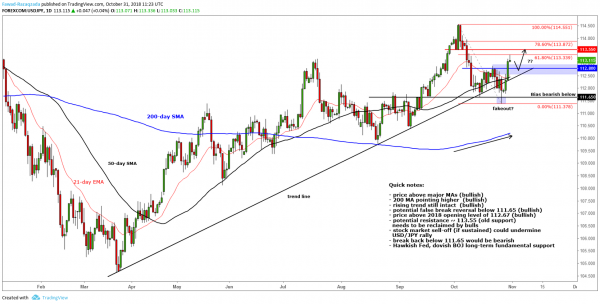While some of the major global central banks have started, or about to start, the process of normalising their monetary policies, there were no signs of that from the Bank of Japan overnight. If anything, the BoJ was slightly dovish in that it actually downgraded its inflation forecasts. Meanwhile with the looming sales tax increase set to squeeze consumers’ disposable incomes next year, policy tightening remains a long way off. For that fundamental reason, the Japanese yen should remain under pressure for the foreseeable future, especially against currencies where the central bank is turning hawkish. Granted, the yen being a safe haven currency will find pockets of strength from time to time, like it did when the stock markets sold off this October. Ultimately, however, the growing disparity of monetary policies between Japan and the faster-growing economies like the US will limit the upside potential for the yen.
So, as indicated above, there was no tricks or treats from BOJ overnight. Virtually no analyst had expected to see a change in interest rates or QE, and that is exactly what the Bank decided to do. The BOJ left its short-term policy rate at -0.1%; the 10-year yield target at 0.0%, and once again reiterated its pledge to keep policy extremely low for “an extended period” and expand JGB holdings by ¥80 trillion per year.
The BOJ obviously remembers that that the previous tax hikes have caused a slump in domestic demand. It wouldn’t make sense therefore to tighten its policy given that the tax hike to 10% from the current 8% is set to come into effect from next October. Therefore we can’t see the BOJ adjusting its policy until at least 2020. The upcoming rise in sales tax is to address Japan’s massive public debt and finance snowballing social security bills due to the aging population, though there are fears it could choke off economic growth.
Focus turns to US dollar ahead of key data releases
As far as the USD/JPY is concerned, there could be more turns and twists for this pair given the upcoming publications of macro pointers from the world’s largest economy this week. US ADP private sectors jobs report and Employment Cost Index will be published shortly, followed on Thursday by the ISM services PMI. Then, the all-important monthly non-farm jobs report will be released on Friday. So, the dollar could be in for a wild ride, depending on the outcome of the upcoming data releases. So far, the greenback has been trending high this week. If the bullish dollar trend continues and given the dovish BoJ, the USD/JPY could be about to stage a sizeable rally.
Technical outlook
Indeed, the USD/JPY currently looks overall bullish than bearish from a technical point of view. Here are the key technical points that we are observing at the moment:
- Price above 21, 50 and 200 moving averages (bullish)
- The 200 MA is pointing higher (bullish)
- Rising trend still intact (bullish)
- Potential false break reversal below 111.65 (bullish)
- Price above 2018 opening level of 112.67 and is therefore positive on the year again (bullish)
- potential resistance ~ 113.55 (old support) needs to be reclaimed by bulls, if so October high at 114.55 could be next bullish objective
- Stock market sell-off (if sustained) could undermine USD/JPY rally – this is the key risk for this pair
- Technically, a break back below 111.65 would be bearish for this would invalidate the false break bullish reversal pattern
The above technical points are for short-term consideration. But in the long-term, the fact we have a hawkish Fed and a dovish BOJ this should keep the USD/JPY supported. The key risk for this pair right now, is if the stock markets were to sell-off again, for this would boost the appeal of the yen as a safe haven currency. Another risk could be if Trump were to sack Jerome Powell as the head of the Federal Reserve, with the US president being rather vocal in his criticism of the Fed’s policy of late.


 Signal2forex.com - Best Forex robots and signals
Signal2forex.com - Best Forex robots and signals




